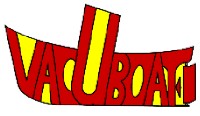Vac-U-Tug Drive Modifications
This page is dedicated to those who can't leave well-enough alone. Whether you want more power, speed, or maneuverability, here you can find some examples of how to get it.
SPEED: A full-displacement hull isn't a speed boat. It is designed for maximum energy efficiency, not for speed. Additional power will result in relatively little additional speed. It will also result in higher amperage draw and shorter battery life. The stock prop and motor will push the tug at it's hull speed. Of course, it has very little extra power so if it is too heavy or pulling another boat, it will run much slower. Having a larger reserve of power will allow the tug to do more work, but not to go much faster by itself.
MANEUVERABILITY: Not much to do here. The new rudder is larger than the original and has better steering in reverse than the original. You can increase the throw of the rudder by changing the rudder linkage at the servo.
This is easily done by moving the EZ-Connector on the Rudder Servo Arm from the 3rd hole, as shown above, to the outer 4th hole. (Good thing you used the plastic keeper on the EZ-Connector!) This increases the throw of the rudder and reduces the turning radius from six feet to about three feet. If you go easy on the rudder, you can still get scale performance, using the reserve after engaging the other craft you are recovering.
POWER: Whether you are pushing a dead sailboat against the wind or towing a mark the size of a watermelon, a little more power could sure be helpful. More power can mean shorter run times though.
Model Boat Rental concessions can appreciate the stock setup because the boats run cool, long, and economically. Also, the speed causes no damage upon collision with other boats or the shoreline.
With urging from Rob, I built a twin-screw Vac-U-Tug Jr. you can read about in the Special Boats section. With two 4-blade props mounted on it, I think I'm ready to handle a large sail boat like an ODOM. We will see. It is a little tough to modify a single-screw hull into a twin-screw hull. This one may have to wait until I can rework the hull and design a new kit for a twin drive system.
While it would be fairly easy to just "drop in" a Speed 400 motor, I wouldn't consider doing that before experimenting with props first. A powerful "380 size" motor like the 400 would overpower the hull and likely need a smaller prop or gear reduction to be of any use as a work boat. It would drain a 1,500 mAh battery in about 15 minutes. It would likely run hot, require cooling, and a mount that would not melt under the heat. Feel free to experiment but read the following first.
Ever since I matched the stock prop to the stock motor in the Vac-U-Tug, I have been looking for inexpensive upgrades that will increase performance about 20% to 25% for those adventuresome folk who want to work the boat in one capacity or another.
For you "adventuresome folk" mentioned above, I have reviewed some props with the Vac-U-Tug for your consideration. Amp-draw and static pull information is now included. If you have tried a prop that gave you the performance boost you were looking for, please send me the details and photos so I can share with all.
Going one step further, I have produced an upgraded drive system designed just for towing larger boats. The upgrade kit draws 2.3 amps and pulls 10 ounces on six cells without overheating. Over 3 times the pull of the stock setup. It is now available and reviewed in the Towing & Recovery section. The motor has the exact dimensions as the stock motor so no drive adjustment is necessary.
It is possible to install a 545 type motor. (5-pole 545 motor has slower speed but more torque than a standard 3-pole 540 motor used in fast electric boats.) You can do some major modifications to the motor tray, or scrap it altogether. Philip in Ann Arbor MI built one. Some details below.
Click on the photos for modification details.
| Pull Chart | |||||
| Boat | Prop | Cruising Amp 6 cells | Pull 6 cells | Cruising Amp 7 cells | Pull 7 cells |
| Stock Tug | Vac-U-Boat 3-Blade | .64 amp | 4.5 oz. | .75 amp | 6 oz. |
| Stock Towboat | Vac-U-Boat 3-Blade | .94 amp | 8.5 oz. | 1.13 amp | 10 oz. |
| Stock Tug with upgrade drive. | 2-blade 1.25 Dumas plastic prop | 2.3 amp | 10 oz. | Not tested. | Not tested. |







 TM
TM